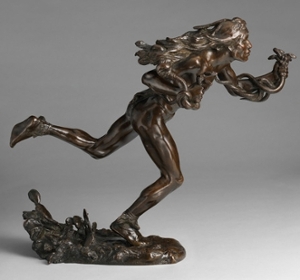Bronze’s Role in the American West
 The Moqui Prayer for the Rain Sculpture
The Moqui Prayer for the Rain SculptureIn 2009, Thomas Smith director of the Petrie Institute of American Art at the Denver Art Museum, was viewing sculptural works with a group of scholars when inspiration struck.
“Bronze sculpture is really synonymous with the American West,” Smith says, so, “it is a little surprising there has never been a full scale exhibit looking at this medium.”
This factor was a motivating force behind the exhibition, The American West in Bronze, 1850 – 1925, considered the first ever full-scale survey of Western American Art.
The co-collaborative effort by Smith and Thayer Tolles, Marica F. Vilcek Curator, American painting and sculpture, the American wing, the Metropolitan Museum of Art in New York, is currently on view at the Met before it travels to the Denver Art Museum (DAM) and then to the Nanjing Museum in China.
“She (Tolles) is a sculpture specialist and mine is the American West,” Smith says. “We thought we had everything covered. What we didn’t plan for is that I would fall in love with sculpture and she would get this deep interest in the American West. In the end, we were entranced by both. It kept us excited and learning new things.”
Smith says that both played an important role for bronze during this period.
“I think of it as the height of representational bronze sculpture in America,” he says. “It is incredibly important at this moment (1850 - 1925). For the first time sculpture in this country is not dependent on Europe. They don’t have to go to Italy or France to have their works cast or Italy to get marble.”
He further described the copper alloy as a “democratic medium”, allowing artists to produce sculptures in America.
“Before, most had to go to Paris or Rome and spend an incredible amount of time in Europe,” says Smith.
The American West in Bronze exhibit at DAM will include pieces depicting symbols of the West, broken down into five subjects: Native Americans, cowboys, wildlife, pioneers and settlers.
“These are the greatest sculptures in America during this 75-year period,” he says. “There are something like 28 different artists in the exhibition--which is remarkable in itself because there are so many artists.”
Smith makes note of the significance of the American West as it played a healing role in the American psyche in a post Civil War America.
 Indian Hunter and Dog
Indian Hunter and Dog“It speaks to the power of the American West in the American imagination at this time,” he says.
The artists featured in the exhibition range from those internationally recognized for their work in bronze such as Frederic Remington and Charles M. Russell to artists who infrequently pursued western subjects such as Frederick William MacMonnies and Paul Manship. Many were rigorously trained in New York and Paris and used sophisticated techniques to produce bronzes that were celebrated at home and abroad as authentically American.
“The American West in Bronze” offers a fresh and compelling look at the complex role that artists played in creating three-dimensional interpretations of the Old West, whether based on fact, fiction or something in-between,” says a spokesperson from the DAM. Smith discusses some of the artists included in the exhibition, which adds a level of intrigue to their work. “Frederic Remington was never trained as a sculptor,” he says. “He didn’t have these self-imposed boundaries. He could just push the medium to do things that other sculptors had never done.”
Smith pointed out some of his favorite works in the exhibition, which include; Hermon Atkins MacNeil’s “The Moqui Prayer for Rain”; Frederic Remington’s “Broncho Buster” and Alexander Phimister Proctor’s “Buckaroo”. “It’s a wonderful cowboy bucking bronco scene,” Smith said of Proctor’s piece. One of the most interesting aspects of the exhibition, according to Smith, is the work included by artists who are not household names among the sixty-five sculptures currently on view at the Met. “The Frederic Remington and Charles Russell, everyone knows,” he said. “They don’t know a Proctor, Solon, MacNeil, Cyrus Dallin. Their work is of the finest quality that you see in America at this moment (1850 – 1925) – that is what gets me excited.”
Smith recognizes the valuable role Paul Manship’s work played during this period. “It’s the first glimpse of a modern aesthetic,” he says. “He totally turns away from the French aesthetic and gets interested in archaic art – a precursor to Art Deco.” Smith brings to light the “incredible diversity” of life experience among the artists. “These are different artists who are portraying the same subject differently at different times,” he says. “There is a great diversity in the artists – some of them were trained in Europe, some of them even did their western works in Paris or Rome, some trained in New York or were self-taught and Westerners who never left the West.”
The allure of the American West wasn’t restricted to artists. “The western bronze statuette was eagerly collected by the urban populace at the turn of the 20th century,” Thomas says. “A century later, no segment of American sculpture remains more appreciated by the public.”
Resources:
Also in this Issue:
- Bronze’s Role in the American West
- Musings with Morningstar Metalworks
- Gage Designs: Creating Jewelry And Instruction with Metal Clay
- Ildanach: Handmade Wearable Art Forged with Spirit And Character
- Stanford Medical Professor Teaches through the Art of Rodin
